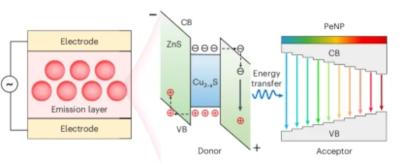Researchers at City University of Hong Kong (CityU) have presented a novel material design strategy and simple device-manufacturing process for skin-conformable perovskite-based alternating-current electroluminescent (PeACEL) devices.
Working mechanism of the PeACEL device. Image credit: Nature Photonics
These devices exhibit a narrow emission bandwidth (full-width at half-maximum, <37 nm), continuously tunable emission wavelength (468–694 nm), high stretchability (400%) and adequate luminance (>200 cd m−2).
Wearable displays require mechanical deformability to conform to the skin, as well as long-term stability, multicolor emission and sufficient brightness to enable practically useful applications. However, designing a single device with all these features presents a challenge, which the team set out to address.
The new approach leverages a new class of perovskite zinc sulfide (PeZS) phosphors, consisting of ZnS phosphors coated with perovskite nanoparticles for electrical excitation via total intraparticle energy transfer.
This strategy results in pure red and green emissions and expands the color gamut of powder-based ACEL devices by 250%.
Moreover, the processing technique facilitates the integration of PeACEL displays with wearable electronics, enabling applications in dynamic interactive displays and visual real-time temperature monitoring. These PeACEL displays offer new routes in flexible electronics and hold potential for the development of efficient artificial skins, robotics and biomedical monitoring devices.




